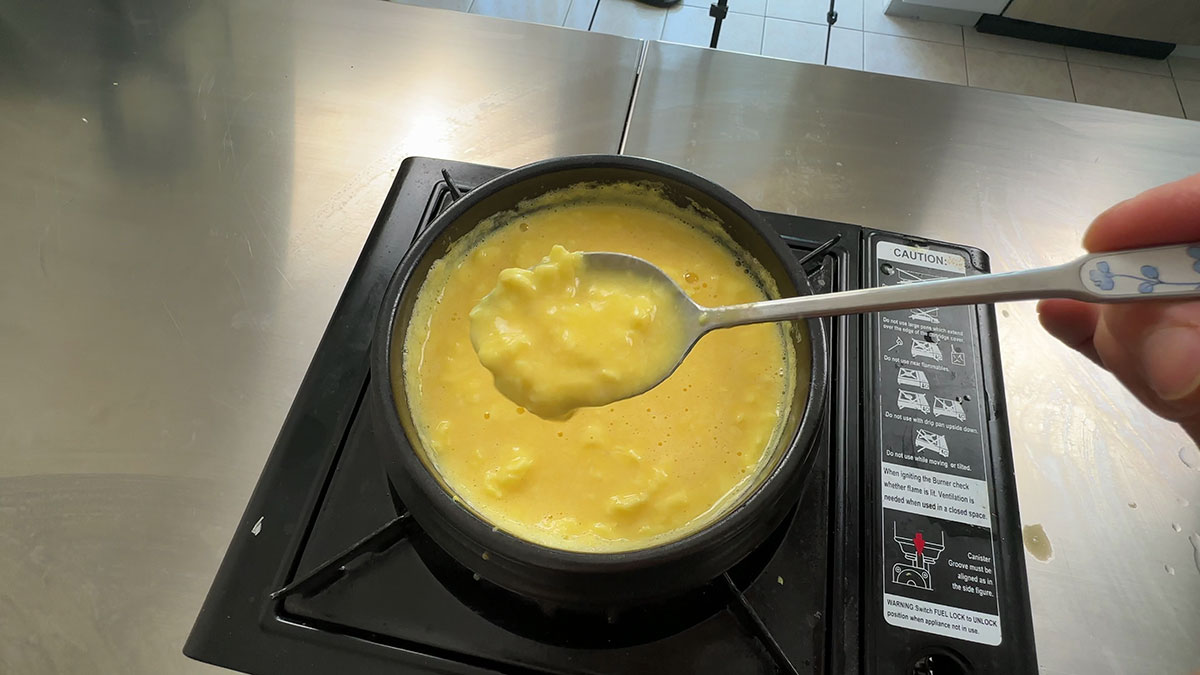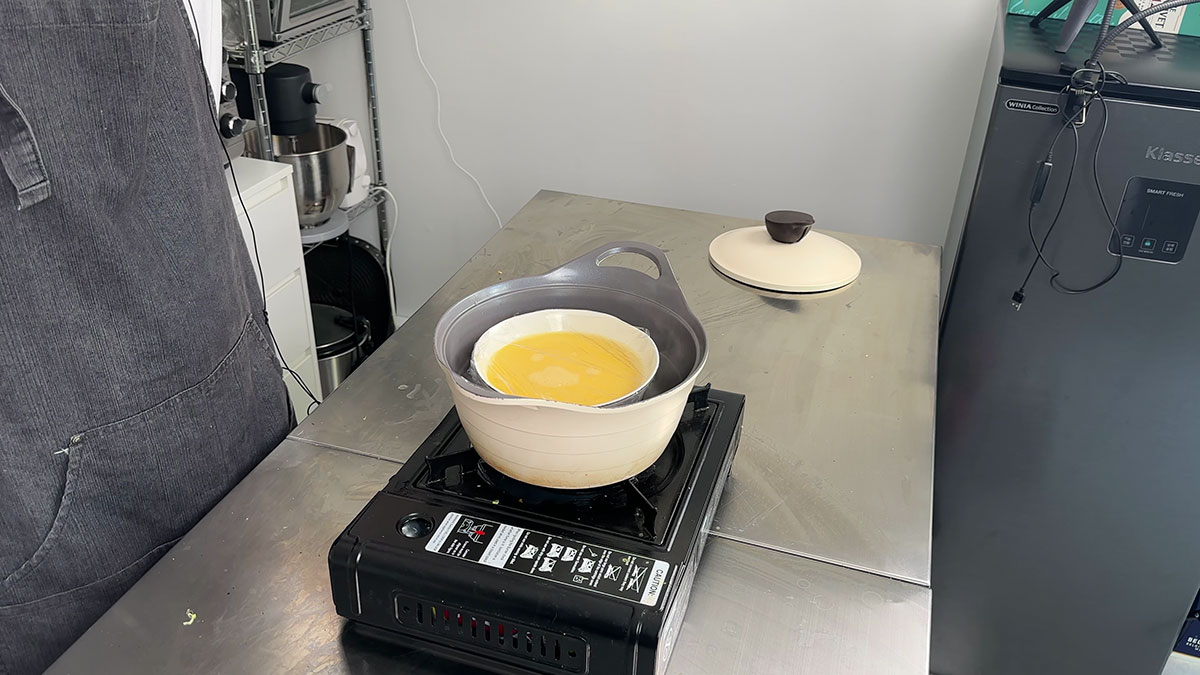
Korean Steamed Eggs are soft, fluffy, and light. It only takes a few ingredients and techniques and you’ll have a great side dish you can serve at any mealtime!
Eggs are super versatile. Across the world, there are literally so many ways that we serve it. For Koreans, it can be sunny side up over rice and some soy sauce, it can be a rolled omelet for your bento box, or it can be soy-marinated hard-boiled egg for a quick savory meal anytime.
Gyeran Jjim is one of my favorite ways of having them. Most of the time when we serve this at the restaurant, people are amazed by how it looks and they are usually wondering how it was achieved. To be honest, many dishes require few ingredients but it needs a lot of patience to learn how to make.
Here I am going to teach you how to make them with and without ttukbaegi. I’ll also share tips on how you can make a simple recipe so much better!
Gyeran Jjim Ingredients

To start, one of the key things you need to remember is the egg and water/broth ratio. If using a ttukbaegi, use 1 cup of egg to 3/4 cup of water/broth. If using a bowl, use 1 cup of egg to 1 cup of water/broth.
To take it up a notch…
- Broth: I highly recommend using stock made from either a boiled dashi packet or water infused with dashima and mushrooms for 3-4 hours. This will give a deeper flavor to the eggs. If these ingredients are unavailable to you, then water is ok.
- Seasoning: The most basic seasoning for this is a teaspoon of salt. If you want the halmoni style (which was literally my grandma’s way of making it), you can use half a teaspoon of seujeot (salted shrimp). Other seasonings you can use are fish sauce and hondashi. Go and experiment, find out which tastes better for you!
- Make it sweet or Add aromatics/vegetables: You can put a teaspoon of sugar if you like your steamed eggs a bit sweet. You can also put chopped-up pieces of scallions, onions, and carrots as add-ons. These are all optional.
How to make traditional Korean Steamed Egg?
The traditional way of steaming eggs is by using a ttukbaegi. It’s a type of bowl made from stone that we commonly use in serving soups and stews. You can cook directly from it and the dish can retain the heat to keep your food hot.
When using a ttukbaegi to cook:

- Step #1: In high heat, mix the egg, scraping the bottom, until clumps are formed and there is a bit of resistance as you swirl. This will keep the eggs from burning while jump-starting the steaming process. Some toasted egg bits are normal at the bottom, but you need to keep mixing so it doesn’t burn all the way through. This step will last around 4 minutes.

- Step #2: Cover the stone bowl with another bowl, then turn your heat to low. Leave it for 1-2 minutes. This will allow for steam to be created and for the eggs to rise, overflow to the brim, and sizzle like a volcano. That’s also the reason why this dish can be called Korean Volcano Eggs!
- Step #3: Turn off the heat and let it sit covered for 2-3 minutes. Again, keep the eggs covered.

When you finish the whole cooking process, be careful in handling the dish as it is super hot. Garnish and serve immediately as the eggs may deflate as soon as it cools down.
How to cook Korean Steamed Egg without an earthenware bowl?
You can also make this simple side dish without the earthenware bowl by using any steamer you have. If you don’t have one, you can easily create a makeshift by:

- Using a deep pot, fill it with about three inches of water, and let boil.
- Put your egg mixture in a heat-proof bowl, cover it with plastic wrap, place the bowl in the middle of the boiling water, then cover. The plastic wrap will keep the steam from dripping into the egg and also help create a nice flat surface.
- Keep your heat on low and the pot closed while steaming for 10 minutes. This ensures the eggs are cooked evenly, and will be kept from burning and overcooking.
- Once done, garnish and serve immediately.

Using an earthenware bowl usually results in a fluffier and lighter gyeran jjim, while using a steamer usually results in a smoother and silkier gyeran jjim. It won’t grow as much but it is the same thing.
I personally prefer the former, but regardless if you’re using a ttukbaegi or a deep pot, do not open and close, open and close it! Every time you open it, it loses steam. These are steamed eggs!
TIP: The ttukbaegi or bowl you will use might have burnt eggs sticking at the bottom. You can just let it soak in water for an hour right after eating so it becomes easier to wash after.
Serving Gyeran Jjim
Once they’re done, garnish with scallions, and season them with a touch of sesame oil and sesame seeds. The nuttiness complements the eggs really well. You need to serve these as soon as they are done so it remains hot and fluffy to eat. Again, be careful because it’s super hot!
If you want an easy meal, you can pair this with a bowl of rice or multigrain rice and kimchi. This is also perfect as a side dish to ramen or some Korean BBQ. It pairs perfectly with anything and you can easily do this any time for your family!
Other Korean side dishes that go perfectly with rice that you may like:
- Spicy Cucumber Salad (Oi Muchim)
- Korean Crab Cakes
- Fish Cake Stir-Fry
- Spicy Dried Squid (Ojingochae Muchim)
- Korean Sausage Stir-Fry
Make sure to leave a rating, a comment, or tag me on Facebook, Instagram, or Tiktok when you chop them up! Yeobosayo!
Disclaimer: I get a small commission at no additional cost to you when you make a qualified purchase under the affiliate links.
Korean Steamed Eggs (Gyeran Jjim)
Equipment
- Tteukbaegi or Stone Bowl Earthenware
- Heat-proof Bowl
- Deep Pot or Steamer
Ingredients
- 5 pcs Eggs
- 3/4 cup Water or Fish Stock If using ttukbaegi
- 1 cup Water or Fish Stock If using bowl and steamer
- 1 tsp Salt
- 1/2 tsp Salted Shrimp, Fish Sauce, or Hondashi Optional
- 1/2 tsp Sugar Optional
- Scallions For garnish
- Sesame Oil For garnish
- Sesame Seeds For garnish
Instructions
- Combine eggs and water or broth, and mix thoroughly.
- Season with salt, salted fish (optional), and sugar (optional). Mix thoroughly.
Using Ttukbaegi
- Pour egg mixture into ttukbaegi.
- In high heat, keep mixing the eggs as you cook, scraping the bottom so it doesn’t burn.
- After 4 minutes, you will see clumps form. Keep stirring until you feel a bit of resistance as you mix.
- Stop and cover ttukbaegi with a bowl or lid. Turn your heat to low for 1-2 minutes.
- Completely turn off the heat and let sit for 2-3 minutes without opening.
- Remove the bowl, be careful as the bowl is extremely hot.
- Garnish with scallions, sesame seeds, and a dash of sesame oil.
- Serve immediately! It’s going to be hot and fluffy, be careful but also enjoy!
Using Bowl and Steamer
- Pour your egg mixture into a heat-proof bowl.
- Remove the bubbles on the surface so it becomes smooth. Cover with a plastic wrap.
- You can use a steamer, but if you don’t have one, in a deep pot, let about 3 inches of water come to a boil.
- Once water is boiling, put the bowl of egg in the middle, then cover to steam.
- Keep it covered for 10 minutes in low heat. Do not keep opening and closing it!
- Garnish with scallions, sesame seeds, and a splash of sesame oil.
- Serve immediately! Enjoy!






Amazing cook
Thank you Tashanda!
How would you recommend one does this recipe with an electric stove top? I have a few ttukbaegi but I don’t think it would work the same without a gas stove or open flame.
I don’t think it will work on an electric stove because ttukbaegi doesn’t have a flat bottom~
Hello. I would like to try this. What is the size of the earthenware you used here?
The 500ml ttukbaegi~